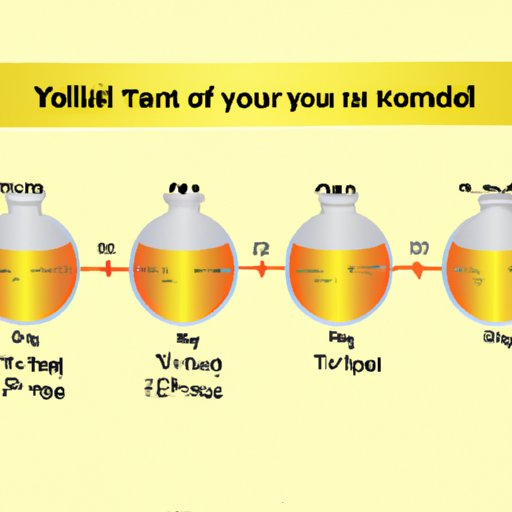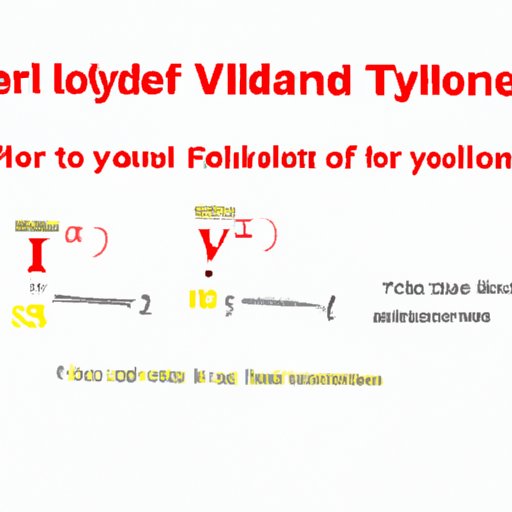
I. Introduction
Theoretical yield is a fundamental concept in chemistry that allows scientists to predict how much product they can expect from a chemical reaction. This information is essential for designing experiments and calculating important parameters, such as reaction efficiency, yield, and purity. In this article, we will explore the key steps involved in finding theoretical yield, the formulas and equations necessary for success, and best practices for accuracy in the lab.
II. The Ultimate Guide to Finding Theoretical Yield: Simple Steps to Success
The process of finding theoretical yield involves a few simple steps:
- Identify the limiting reactant in the reaction
- Determine the stoichiometric ratio between the limiting reactant and the product
- Calculate the theoretical yield using the stoichiometric ratio and the amount of limiting reactant used
The key formulas and equations for finding theoretical yield include:
- Stoichiometric ratio: determines the ratio of reactants and products in a chemical reaction
- Molar mass: used to convert between mass and moles of a substance
- Mole ratio: shows the stoichiometric relationship between reactants and products in a chemical reaction
- Theoretical yield: the maximum amount of product that can be produced in a chemical reaction
Examples of calculations for finding theoretical yield include:
- Calculating the theoretical yield of water from the reaction of 2 moles of hydrogen gas and 1 mole of oxygen gas
- Calculating the theoretical yield of carbon dioxide from the combustion of 4 moles of methane

III. Unlocking the Formula: How to Solve for Theoretical Yield
To calculate theoretical yield, we use the formula:
Theoretical Yield = (Amount of Limiting Reactant) x (Conversion Factor) x (Molar Mass of Product)
The conversion factor is determined from the stoichiometric ratio between the limiting reactant and the product.
This formula can be applied to different chemical reactions by first identifying the limiting reactant and then calculating the stoichiometric ratio and molar mass of the product.
Common mistakes to avoid when using this formula include not converting all units to the same system of measurement and not accounting for significant figures.
IV. Theoretical Yield 101: Everything You Need to Know
Factors that affect theoretical yield include:
- Purity of reactants
- Reaction conditions (temperature, pressure, catalysts)
- Reaction stoichiometry
Theoretical yield can be compared to actual yield to determine the efficiency of a reaction. Actual yield is measured in the lab and may be lower than the theoretical yield due to factors such as incomplete reactions, loss of product during purification, or experimental error.
Good lab practices are essential for accurate theoretical yield calculations. This includes precise measurements, proper sampling techniques, and careful analysis and interpretation of data.
V. From Experiment to Calculation: How to Determine Theoretical Yield
The process of determining theoretical yield involves:
- Performing a chemical reaction in the lab
- Measuring the amount of limiting reactant used
- Calculating the stoichiometric ratio and molar mass of the product
- Using the formula to calculate theoretical yield
Methods for determining theoretical yield include:
- Volumetric analysis
- Gravimetric analysis
- Spectroscopic analysis
Each method has advantages and disadvantages, such as accuracy, precision, and speed of analysis.
VI. Mastering Theoretical Yield: Tips for Success in the Lab
To ensure accurate theoretical yield calculations, it is important to follow best practices in the lab, including:
- Using clean, calibrated equipment
- Measuring and recording data carefully
- Conducting experiments in a controlled environment
When interpreting results, it is important to consider factors such as experimental error, purity of reactants, and reaction efficiency. These factors can affect the accuracy of the theoretical yield calculation and should be taken into account when drawing conclusions.
VII. The Roadmap to Theoretical Yield: A Step-by-Step Guide
To find theoretical yield, follow these step-by-step instructions:
- Identify the limiting reactant in the reaction
- Calculate the stoichiometric ratio between the limiting reactant and the product
- Determine the molar mass of the product
- Measure the amount of limiting reactant used
- Convert the amount of limiting reactant to moles
- Calculate theoretical yield using the formula
Clear examples and visual aids can help simplify this process and make it easier to understand. Troubleshooting tips, such as how to recognize and correct common errors, can also be helpful.
VIII. The Art of Theoretical Yield: Techniques for Accurate Results
Advanced techniques for finding theoretical yield include:
- Quantitative analysis
- Statistical analysis
- Kinetic analysis
These techniques involve more complex calculations and can provide a more detailed understanding of the reaction process. However, they also require more time and resources than simpler methods.
When incorporating advanced techniques into lab practice, it is important to evaluate the benefits and drawbacks of each method and select the technique that best meets the needs of the experiment.
IX. Conclusion
In conclusion, finding theoretical yield is a key concept in chemistry that enables researchers to design experiments and make predictions about the products of chemical reactions. The formula for theoretical yield involves a few simple steps, including identifying the limiting reactant, calculating the stoichiometric ratio, and measuring the amount of reactant used. Advanced techniques for finding theoretical yield can provide a more detailed understanding of the reaction process. By following best practices in the lab and avoiding common mistakes, researchers can achieve accurate and dependable theoretical yield calculations for a wide range of applications.
Don’t be afraid to put these techniques into practice and experiment with different methods.




